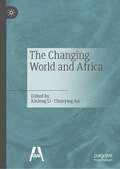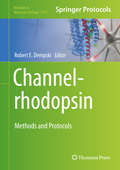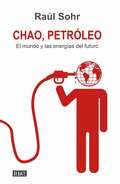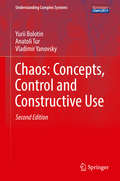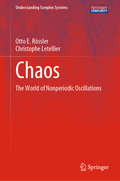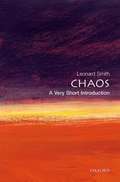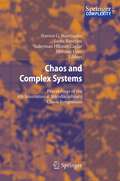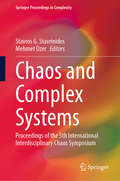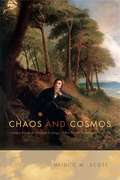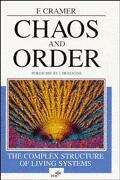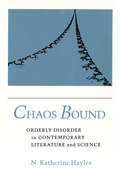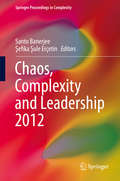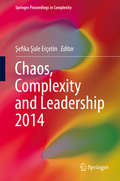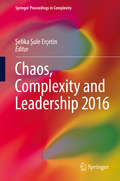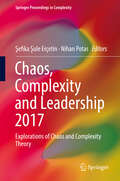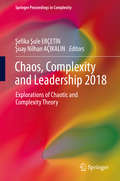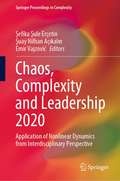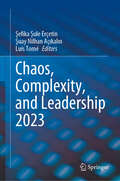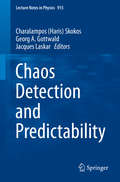- Table View
- List View
The Changing World and Africa
by Xinfeng Li Chunying AnThis book brings contemporary Chinese scholarship into Africa, the relations between African states, and the relations between China and Africa into focus. As China becomes the biggest partner for many African states, constructing infrastructure across the continent, Western scrutiny has increased. This book offers a comprehensive look at what Chinese scholars have encountered on the ground, as well as comparative studies of how different nations have engaged with Africa.
Changjiang Riverine and Estuarine Hydro-morphodynamic Processes: In the Context of Anthropocene Era
by Zhijun DaiThis book provides a comprehensive and systematic analysis of the morphodynamic process of the Changjiang River from upstream to estuary in the Anthropocene. As the longest river in China, the Changjiang River has nurtured Chinese civilization with ample natural resources for thousands of years. Evidence highlights that the Changjiang River has experienced intensive human interference and indicated dramatic changes in the Anthropocene, including “no flood in flood season, no dry in dry season” in discharge; “less flood in flood season, more dry in dry season” in sediment; riverbed shifts from accretion to erosion; lakes in the middle-lower reach turn from sediment sink to source; estuarine tidal flat exhibits self-organization characteristics and maintains the current accretion state; estuarine branches that connect to the sea show district morphodynamic patterns; and depocenters of the submerged delta indicate periodic shifts. The book stresses that dam construction upstream, practically the Three Gorges Dam, the world’s largest hydraulic engineering project, has significant influences on the hydrology and geomorphology of the middle-lower reach but has a slight effect on estuarine delta development. The geomorphological structure of the estuarine channel is dominated by local land reclamation, navigation, and dredging. This book clarifies the river-estuary morphodynamics of the Changjiang River and indicates the general features of global mega rivers under human interference as well as their own response mechanisms. This book also exhibits the potential risk of river-estuary deltas in the future, as both material and dynamics are experiencing acceleration adjustment.
Channeling and Radiation in Periodically Bent Crystals (Springer Series on Atomic, Optical, and Plasma Physics #69)
by Walter Greiner Andrey V Korol Andrey V Solov'YovThe development of coherent radiation sources for sub-angstrom wavelengths - i.e. in the hard X-ray and gamma-ray range - is a challenging goal of modern physics. The availability of such sources will have many applications in basic science, technology and medicine, and, in particular, they may have a revolutionary impact on nuclear and solid state physics, as well as on the life sciences. The present state-of-the-art lasers are capable of emitting electromagnetic radiation from the infrared to the ultraviolet, while free electron lasers (X-FELs) are now entering the soft X-ray region. Moving further, i.e. into the hard X and/or gamma ray band, however, is not possible without new approaches and technologies. In this book we introduce and discuss one such novel approach: the focus is on the radiation formed in a Crystalline Undulator, where electromagnetic radiation is generated by a bunch of ultra-relativistic particles channeling through a periodically bent crystalline structure. It is shown that under certain conditions, such a device emits intensive spontaneous monochromatic radiation and may even reach the coherence of laser light sources. Readers will be presented with the underlying fundamental physics and be familiarized with the theoretical, experimental and technological advances made during the last one and a half decades in exploring the various features of investigations into crystalline undulators. This research draws upon knowledge from many research fields - such as materials science, beam physics, the physics of radiation, solid state physics and acoustics, to name but a few. Accordingly, much care has been taken by the authors to make the book as self-contained as possible in this respect, so as to also provide a useful introduction to this emerging field to a broad readership of researchers and scientist with various backgrounds.
Channeling and Radiation in Periodically Bent Crystals (Springer Series on Atomic, Optical, and Plasma Physics #69)
by Andrey V Korol Andrey V Solov'yov Walter GreinerThe development of coherent radiation sources for sub-angstrom wavelengths - i.e. in the hard X-ray and gamma-ray range - is a challenging goal of modern physics. The availability of such sources will have many applications in basic science, technology and medicine, and, in particular, they may have a revolutionary impact on nuclear and solid state physics, as well as on the life sciences.The present state-of-the-art lasers are capable of emitting electromagnetic radiation from the infrared to the ultraviolet, while free electron lasers (X-FELs) are now entering the soft X-ray region. Moving further, i.e. into the hard X and/or gamma ray band, however, is not possible without new approaches and technologies. In this book we introduce and discuss one such novel approach: the focus is on the radiation formed in a Crystalline Undulator, where electromagnetic radiation is generated by a bunch of ultra-relativistic particles channeling through a periodically bent crystalline structure. It is shown that under certain conditions, such a device emits intensive spontaneous monochromatic radiation and may even reach the coherence of laser light sources. Readers will be presented with the underlying fundamental physics and be familiarized with the theoretical, experimental and technological advances made during the last one and a half decades in exploring the various features of investigations into crystalline undulators. This research draws upon knowledge from many research fields - such as materials science, beam physics, the physics of radiation, solid state physics and acoustics, to name but a few. Accordingly, much care has been taken by the authors to make the book as self-contained as possible in this respect, so asto also provide a useful introduction to this emerging field to a broad readership of researchers and scientist with various backgrounds.
Channelrhodopsin: Methods and Protocols (Methods in Molecular Biology #2191)
by Robert E. DempskiThis book merges approaches in understanding the function of the light-gated ion channels known as channelrhodopsin together with methods addressing how channelrhodopsins can be used to address biomedical questions on a cellular or organismal level. Since the first molecular identification of channelrhodopsins, a broad range of tools have been created and new approaches developed to both better understand the molecular determinants of channelrhodopsin function as well as to use these and homologous proteins from a variety of species as tools to better understand physiological processes, which this volume addresses. Additionally, channelrhodopsins have become instrumental as a potential treatment for disease states. Written for the highly successful Methods in Molecular Biology series, chapters include introductions to their respective topics, lists of the necessary materials and reagents, step-by-step, readily reproducible laboratory protocols, and tips on troubleshooting and avoiding known pitfalls. Authoritative and practical, Channelrhodopsin: Methods and Protocols provides a resource for those interested in honing their current expertise in this vital area of study as well as potentially branching out into new directions.
Chao Petroleo: El mundo de las energias del futuro
by Raúl Sohr«Un completo panorama que va desde la amenaza del calentamiento global hasta las nuevas energías.» Le Monde Diplomatique El petróleo se agota y el calentamiento global asfixia al planeta. Una encrucijada frente a la cual habrá que elegir entre mantener el rumbo que conduce a una reacción en cadena de desastres ambientales (ahí está el pozo de BP en el Golfo de México, provocando uno de los mayores derrames de petróleo de la historia, para atestiguarlo) o avanzar hacia un cambio de paradigma que entraña complejos desafíos. Raúl Sohr revisa la historia de dependencia de los combustibles fósiles y muestra hasta qué punto el crudo fue el causante de las guerras del siglo XX. A la vez, da cuenta de cómo la cultura de consumo sin límites se torna inviable en una Tierra de recursos finitos. Chao, petróleo es una obra que nos revela los cambios que enfrentaremos, tanto en los planos políticos más globales como en nuestra vida cotidiana. Desde la cruel huella de carbono que amenaza con la destrucción de nuestro hábitat, hasta las nuevas energías que aseguran una existencia balanceada. Un libro profundo e informado que nos permite entender el mundo que nos espera. «Raúl Sohr nos remece nuevamente con un libro de importanciatrascendental.» Alejandro Guillier
Chaos: Concepts, Control And Constructive Use (Understanding Complex Systems)
by Yurii Bolotin Anatoli Tur Vladimir YanovskyThis book offers a short and concise introduction to the many facets of chaos theory. While the study of chaotic behavior in nonlinear, dynamical systems is a well-established research field with ramifications in all areas of science, there is a lot to be learnt about how chaos can be controlled and, under appropriate conditions, can actually be constructive in the sense of becoming a control parameter for the system under investigation, stochastic resonance being a prime example. The present work stresses the latter aspects and, after recalling the paradigm changes introduced by the concept of chaos, leads the reader skillfully through the basics of chaos control by detailing the relevant algorithms for both Hamiltonian and dissipative systems, among others. The main part of the book is then devoted to the issue of synchronization in chaotic systems, an introduction to stochastic resonance, and a survey of ratchet models. In this second, revised and enlarged edition, two more chapters explore the many interfaces of quantum physics and dynamical systems, examining in turn statistical properties of energy spectra, quantum ratchets, and dynamical tunneling, among others. This text is particularly suitable for non-specialist scientists, engineers, and applied mathematical scientists from related areas, wishing to enter the field quickly and efficiently. From the reviews of the first edition: This book is an excellent introduction to the key concepts and control of chaos in (random) dynamical systems [. . . ] The authors find an outstanding balance between main physical ideas and mathematical terminology to reach their audience in an impressive and lucid manner. This book is ideal for anybody who would like to grasp quickly the main issues related to chaos in discrete and continuous time. Henri Schurz, Zentralblatt MATH, Vol. 1178, 2010.
Chaos: Making a New Science
by James GleickThe &“highly entertaining&” New York Times bestseller, which explains chaos theory and the butterfly effect, from the author of The Information (Chicago Tribune). For centuries, scientific thought was focused on bringing order to the natural world. But even as relativity and quantum mechanics undermined that rigid certainty in the first half of the twentieth century, the scientific community clung to the idea that any system, no matter how complex, could be reduced to a simple pattern. In the 1960s, a small group of radical thinkers began to take that notion apart, placing new importance on the tiny experimental irregularities that scientists had long learned to ignore. Miniscule differences in data, they said, would eventually produce massive ones—and complex systems like the weather, economics, and human behavior suddenly became clearer and more beautiful than they had ever been before.In this seminal work of scientific writing, James Gleick lays out a cutting edge field of science with enough grace and precision that any reader will be able to grasp the science behind the beautiful complexity of the world around us. With more than a million copies sold, Chaos is &“a groundbreaking book about what seems to be the future of physics&” by a writer who has been a finalist for both the Pulitzer Prize and the National Book Award, the author of Time Travel: A History and Genius: The Life and Science of Richard Feynman (Publishers Weekly).
Chaos: The World of Nonperiodic Oscillations (Understanding Complex Systems #Vol. 84)
by Otto E. Rössler Christophe LetellierWritten in the 1980s by one of the fathers of chaos theory, Otto E. Rössler, the manuscript presented in this volume eventually never got published. Almost 40 years later, it remains astonishingly at the forefront of knowledge about chaos theory and many of the examples discussed have never been published elsewhere. The manuscript has now been edited by Christophe Letellier - involved in chaos theory for almost three decades himself, as well as being active in the history of sciences - with a minimum of changes to the original text.Finally released for the benefit of specialists and non-specialists alike, this book is equally interesting from the historical and the scientific points of view: an unconventionally modern approach to chaos theory, it can be read as a classic introduction and short monograph as well as a collection of original insights into advanced topics from this field.
Chaos: A Very Short Introduction
by Leonard A. SmithChaos exists in systems all around us. Even the simplest system can be subject to chaos, denying us accurate predictions of its behavior, and sometimes giving rise to astonishing structures of large-scale order. Here, Leonard Smith shows that we all have an intuitive understanding of chaotic systems. He uses accessible math and physics to explain Chaos Theory, and points to numerous examples in philosophy and literature that illuminate the problems. This book provides a complete understanding of chaotic dynamics, using examples from mathematics, physics, philosophy, and the real world, with an explanation of why chaos is important and how it differs from the idea of randomness. The author's real life applications include the weather forecast, a pendulum, a coin toss, mass transit, politics, and the role of chaos in gambling and the stock market. Chaos represents a prime opportunity for mathematical lay people to finally get a clear understanding of this fascinating concept.
Chaos and Complex Systems: Proceedings of the 4th International Interdisciplinary Chaos Symposium (Understanding Complex Systems)
by Santo Banerjee Mehmet Ozer Stavros G. Stavrinides Suleyman Hikmet CaglarComplexity Science and Chaos Theory are fascinating areas of scientific research with wide-ranging applications. The interdisciplinary nature and ubiquity of complexity and chaos are features that provides scientists with a motivation to pursue general theoretical tools and frameworks. Complex systems give rise to emergent behaviors, which in turn produce novel and interesting phenomena in science, engineering, as well as in the socio-economic sciences. The aim of all Symposia on Chaos and Complex Systems (CCS) is to bring together scientists, engineers, economists and social scientists, and to discuss the latest insights and results obtained in the area of corresponding nonlinear-system complex (chaotic) behavior. Especially for the "4th International Interdisciplinary Chaos Symposium on Chaos and Complex Systems," which took place April 29th to May 2nd, 2012 in Antalya, Turkey, the scope of the symposium had been further enlarged so as to encompass the presentation of work from circuits to econophysics, and from nonlinear analysis to the history of chaos theory. The corresponding proceedings collected in this volume address a broad spectrum of contemporary topics, including but not limited to networks, circuits, systems, biology, evolution and ecology, nonlinear dynamics and pattern formation, as well as neural, psychological, psycho-social, socio-economic, management complexity and global systems.
Chaos and Complex Systems: Proceedings of the 5th International Interdisciplinary Chaos Symposium (Springer Proceedings in Complexity)
by Mehmet Ozer Stavros G. StavrinidesThis book presents the proceedings of the “5th International Interdisciplinary Chaos Symposium on Chaos and Complex Systems (CCS).” All Symposia in the series bring together scientists, engineers, economists and social scientists, creating a vivid forum for discussions on the latest insights and findings obtained in the areas of complexity, nonlinear dynamics and chaos theory, as well as their interdisciplinary applications. The scope of the latest Symposium was enriched with a variety of contemporary, interdisciplinary topics, including but not limited to: fundamental theory of nonlinear dynamics, networks, circuits, systems, biology, evolution and ecology, fractals and pattern formation, nonlinear time series analysis, neural networks, sociophysics and econophysics, complexity management and global systems.
Chaos and Complexity in Psychology
by Stephen J. Guastello Matthijs Koopmans David Pincus Stephen J. Guastello Matthijs KoopmansWhile many books have discussed methodological advances in nonlinear dynamical systems theory (NDS), this volume is unique in its focus on NDS's role in the development of psychological theory. After an introductory chapter covering the fundamentals of chaos, complexity, and other nonlinear dynamics, subsequent chapters provide in-depth coverage of each of the specific topic areas in psychology. A concluding chapter takes stock of the field as a whole, evaluating important challenges for the immediate future. The chapters are written by experts in the use of NDS in each of their respective areas, including biological, cognitive, developmental, social, organizational, and clinical psychology. Each chapter provides an in-depth examination of theoretical foundations and specific applications and a review of relevant methods. This edited collection represents the state of the art in NDS science across the disciplines of psychology.
Chaos and Cosmos: Literary Roots of Modern Ecology in the British Nineteenth Century
by Heidi C. ScottIn Chaos and Cosmos, Heidi Scott integrates literary readings with contemporary ecological methods to investigate two essential and contrasting paradigms of nature that scientific ecology continues to debate: chaos and balance. Ecological literature of the Romantic and Victorian eras uses environmental chaos and the figure of the balanced microcosm as tropes essential to understanding natural patterns, and these eras were the first to reflect upon the ecological degradations of the Industrial Revolution. Chaos and Cosmos contends that the seed of imagination that would enable a scientist to study a lake as a microcosmic world at the formal, empirical level was sown by Romantic and Victorian poets who consciously drew a sphere around their perceptions in order to make sense of spots of time and place amid the globalizing modern world. This study’s interest goes beyond likening literary tropes to scientific aesthetics; it aims to theorize the interdisciplinary history of the concepts that underlie our scientific understanding of modern nature. Paradigmatic ecological ideas such as ecosystems, succession dynamics, punctuated equilibrium, and climate change are shown to have a literary foundation that preceded their status as theories in science. This book represents an elevation of the prospects of ecocriticism toward fully developed interdisciplinary potentials of literary ecology.
Chaos and Cosmos: Literary Roots of Modern Ecology in the British Nineteenth Century
by Heidi C. ScottIn Chaos and Cosmos, Heidi Scott integrates literary readings with contemporary ecological methods to investigate two essential and contrasting paradigms of nature that scientific ecology continues to debate: chaos and balance. Ecological literature of the Romantic and Victorian eras uses environmental chaos and the figure of the balanced microcosm as tropes essential to understanding natural patterns, and these eras were the first to reflect upon the ecological degradations of the Industrial Revolution. Chaos and Cosmos contends that the seed of imagination that would enable a scientist to study a lake as a microcosmic world at the formal, empirical level was sown by Romantic and Victorian poets who consciously drew a sphere around their perceptions in order to make sense of spots of time and place amid the globalizing modern world. This study’s interest goes beyond likening literary tropes to scientific aesthetics; it aims to theorize the interdisciplinary history of the concepts that underlie our scientific understanding of modern nature. Paradigmatic ecological ideas such as ecosystems, succession dynamics, punctuated equilibrium, and climate change are shown to have a literary foundation that preceded their status as theories in science. This book represents an elevation of the prospects of ecocriticism toward fully developed interdisciplinary potentials of literary ecology.
Chaos and Order: The Complex Structure of Living Systems
by Friedrich CramerMolecular biologist Cramer explores how recent revelations about nonlinear systems enhance our perceptions of nature. Each chapter begins with a semi-fictitious dialogue and ends with a poem by the likes of Yeats, Dickinson, and Stevens. Of interest to specialist and nonspecialist scientists and to general readers who are basically familiar with scientific principles.
Chaos Bound: Orderly Disorder in Contemporary Literature and Science
by N. Katherine HaylesN. Katherine Hayles here investigates parallels between contemporary literature and critical theory and the science of chaos. She finds in both scientific and literary discourse new interpretations of chaos, which is seen no longer as disorder but as a locus of maximum information and complexity. She examines structures and themes of disorder in The Education of Henry Adams, Doris Lessing’s Golden Notebook, and works by Stanislaw Lem. Hayles shows how the writings of poststructuralist theorists including Barthes, Lyotard, Derrida, Serres, and de Man incorporate central features of chaos theory.
Chaos, Complexity and Leadership 2013 (Springer Proceedings in Complexity)
by Santo Banerjee Şefika Şule ErçetinThese proceedings from the 2013 symposium on "Chaos, complexity and leadership" reflect current research results from all branches of Chaos, Complex Systems and their applications in Management. Included are the diverse results in the fields of applied nonlinear methods, modeling of data and simulations, as well as theoretical achievements of Chaos and Complex Systems. Also highlighted are Leadership and Management applications of Chaos and Complexity Theory.
Chaos, Complexity and Leadership 2014 (Springer Proceedings in Complexity)
by Şefika Şule ErçetinThis work represents the third entry of the series of works on "Chaos, Complexity and Leadership". Contents of the book are composed from broad range of chaos, complexity and their applications in multi disciplines. Articles reflect different perspectives in the field of applied nonlinear methods, modeling of data and simulations as well as theoretical achievements of chaos and complex systems. In addition to this, readers are going to find new applications in leadership and management of chaos and complexity theory such as in fields from education to politics. It is completely new and fresh piece of mind for readers who are interested in chaos, complexity and especially leadership.
Chaos, Complexity and Leadership 2016
by Şefika Şule ErçetinThis book covers the proceedings from the 2016 International Symposium on Chaos, Complexity and Leadership, and reflects current research results of chaos and complexity studies and their applications in various fields. Included are research papers in the fields of applied nonlinear methods, modeling of data and simulations, as well as theoretical achievements of chaos and complex systems. Also discussed are leadership and management applications of chaos and complexity theory.
Chaos, Complexity and Leadership 2017: Explorations Of Chaos And Complexity Theory (Springer Proceedings in Complexity)
by Nihan Potas Şefika Şule ErçetinThe proceedings of the 2017 Symposium on Chaos, Complexity and Leadership illuminate current research results and academic work from the fields of physics, mathematics, education, economics, as well as management and social sciences. The text explores chaotic and complex systems, as well as chaos and complexity theory in view of their applicability to management and leadership.This proceedings explores non-linearity as well as data-modelling and simulation in order to uncover new approaches and perspectives. Effort will not be spared in bringing theory into practice while exploring leadership and management-laden concepts. This book will cover the analysis of different chaotic developments from different fields within the concepts of chaos and complexity theory. Researchers and students in the field will find answers to questions surrounding these intertwined and compelling fields.
Chaos, Complexity and Leadership 2018: Explorations of Chaotic and Complexity Theory (Springer Proceedings in Complexity)
by Şefika Şule Erçeti̇n Şuay Nilhan AçikalinThis book constitutes the proceedings of the 6th International Symposium on Chaos, Complexity and Leadership (ICCLS). Written by interdisciplinary researchers and students from the fields of mathematics, physics, education, economics, political science, statistics, the management sciences and social sciences, the peer-reviewed contributions explore chaotic and complex systems, as well as chaos and complexity theory in the context of their applicability to management and leadership. The book discusses current topics, such as complexity leadership in the healthcare fields and tourism industry, conflict management and organization intelligence, and presents practical applications of theoretical concepts, making it a valuable resource for managers and leaders.
Chaos, Complexity and Leadership 2020: Application of Nonlinear Dynamics from Interdisciplinary Perspective (Springer Proceedings in Complexity)
by Şefika Şule Erçetin Şuay Nilhan Açıkalın Emir VajzovićThis book analyzes a range of new developments in various fields concerning the concepts of chaos and complexity theory. The proceedings of the 7th International Symposium on Chaos, Complexity and Leadership feature newly developed concepts involving various research methodologies for identifying chaos and complexity in different fields of the sciences and leadership. In addition, it explores chaotic and complex systems from all fields of knowledge in order to stake a claim of prevalence of compatibility between knowledge fields. Particular emphasis is placed on exploring non-linearity in order to open a discussion on new approaches to and perspectives on chaos, complexity and leadership. Readers will find coverage of important events that have recently taken place in our world, regardless of whether they were social, political, economic or scientific in nature. The book explores diverse aspects of and issues related to the effects of chaos and complexity in the world; discusses the application of nonlinear dynamics in order to arrive at transformational policies; and offers projections of tomorrow’s world using an interdisciplinary approach. Though primarily intended for readers with an interest in nonlinear science, thanks to its focus on the application of chaos and complexity to other disciplines, the book appeals to a broad readership.
Chaos, Complexity, and Leadership 2023
by Şefika Şule Erçetin Şuay Nilhan Açıkalın Luís ToméThe proceedings of the 8th International Symposium on Chaos, Complexity, and Leadership present various concepts of diverse research methodologies to explore chaos and complexity across different scientific fields of leadership. Particular emphasis will be placed on investigating non-linearity to stimulate discussion on novel approaches and perspectives regarding chaos, complexity, and leadership. The book delves into recent developments from diverse fields, employing chaos and complexity theory as analytical tools. Readers will find insights into important contemporary events, regardless of the various perspectives across social, political, economic, or scientific domains. It integrates numerous aspects and challenges regarding the impact of chaos and complexity on our world, utilizing nonlinear dynamics to suggest transformative policies. It aims to investigate and predict future paths through an interdisciplinary approach. Given the current societal and economic turbulence, leadership across all sectors necessitates reassessment. Consequently, this book primarily targets individuals interested in nonlinear science and leadership. However, its content extends its appeal to a broader audience due to its application of chaos and complexity to other disciplines. The primary audience comprises academics, professionals, and decision-makers seeking to implement new approaches and methodologies in practice.
Chaos Detection and Predictability (Lecture Notes in Physics #915)
by Charalampos Haris Skokos Georg A. Gottwald Jacques LaskarDistinguishing chaoticity from regularity in deterministic dynamical systems and specifying the subspace of the phase space in which instabilities are expected to occur is of utmost importance in as disparate areas as astronomy, particle physics and climate dynamics. To address these issues there exists a plethora of methods for chaos detection and predictability. The most commonly employed technique for investigating chaotic dynamics, i. e. the computation of Lyapunov exponents, however, may suffer a number of problems and drawbacks, for example when applied to noisy experimental data. In the last two decades, several novel methods have been developed for the fast and reliable determination of the regular or chaotic nature of orbits, aimed at overcoming the shortcomings of more traditional techniques. This set of lecture notes and tutorial reviews serves as an introduction to and overview of modern chaos detection and predictability techniques for graduate students and non-specialists. The book covers theoretical and computational aspects of traditional methods to calculate Lyapunov exponents, as well as of modern techniques like the Fast (FLI), the Orthogonal (OFLI) and the Relative (RLI) Lyapunov Indicators, the Mean Exponential Growth factor of Nearby Orbits (MEGNO), the Smaller (SALI) and the Generalized (GALI) Alignment Index and the '0-1' test for chaos.
